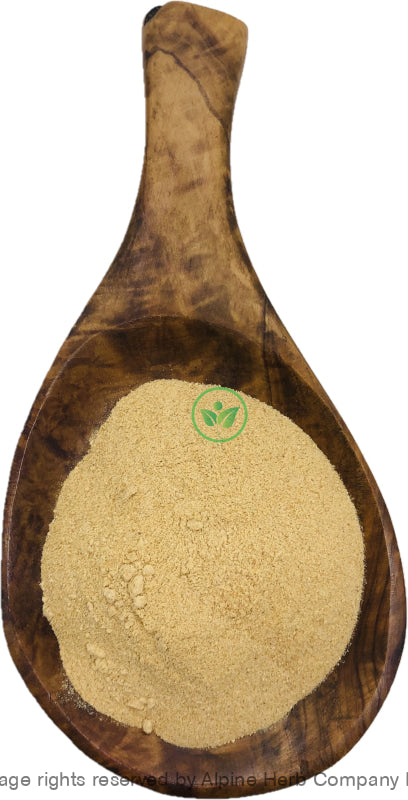Chicory Root Powder Raw Alpine Herb Company Inc.
$ 9,49 $ 5,69
Botanical Name: Cichorium intybus
Common Name:
- English: Chicory
- Ayurveda: Kaasani.
- Also, known as: Succory, Wild Succory, Hendibeh, Barbe de capuchin, Kaasani Dashti (Barri),Kasinikkeerai, Achicoria, Blue Sailors, Cheveux de Paysans, Chicorée, Chicorée Amère,Chicorée Sauvage, Cichorii Herba, Cichorii Radix, Common Chicory Root, Écoubette, Herbe à Café, Hinduba, Kasani, Kasni, Racine de Chicorée Commune, Wild Chicory, Wild Endive, and Yeux de Chat.
Habitat: Europe & Asia
Origin: India
Harvested: Cultivated
Parts Used: Root
General Information:
Cichorium intybus is a perennial plant. The stems are erect and multi-branched and 2-3 feet in height. The lower leaves of the plant are large and spreading – thickly covered with hairs, something like the form of the Dandelion leaf, except that the numerous lateral segments or lobes are in a general direction about at a right angle with the central stem, instead of pointing downwards, as in similar portions of the leaf of the Dandelion. Bright or light blue flowers grow in clusters of two or three, opening with the sunrise and closing by midday. The general aspect of the plant is somewhat stiff and angular. Found in open or grassy areas, along roadsides and parking lots.
Chicory leaves are often eaten like celery, and the roots and leaf buds are boiled and eaten. Chicory is also used as a cooking spice and to flavor foods and beverages. Coffee mixes often include ground chicory to enhance the richness of the coffee
It has been suggested that the name Succory came from the Latin succurrere (to run under), because of the depth to which the root penetrates.
How to use:
Powdered Herb:
There are different ways to use powdered herb.
Food Preparation: You can add powdered herb to any super food herbal smoothie, sauces, spreads and even cookies. Also for children, you can mix powdered herb with honey or glycerin to make paste. The thicker the paste, the more potent and herbal in taste. The sweet taste of honey and glycerin will help medicine go down. This method is also known as “Electuaries”.
Capsules: Encapsulating your own powdered herb at home, gives you assurance that the contents of the capsules are pure herb and no filler or any other products. These capsules can be taken with liquid.
Poultice: Poultice can be made with an herbal powder and liquid (mostly water) to form a paste which is then applied to the skin. This method is very helpful for skin conditions.
Herbal shot: Powdered herb can be mixed with water, fruit juice or other liquid to make herbal shot.
Precautions:
You should consult with a qualified healthcare practitioner before using any herbal products, particularly if you are pregnant, nursing, or on any medications.
All information on this website is for educational purpose ONLY
This information has not been evaluated by Health Canada.
This information is not intended to diagnose, treat, cure, or prevent any disease.
| Unit Size | 100g, 200g, 400g, 1kg |
|---|
Prompt shipping and expert packing
Thanks to our longstanding association with UPS FedEx DHL as well as other leading global carriers, we can offer a variety shipping options. Our warehouse staff is highly trained and will be able to pack your goods in accordance with our precise and exact specifications. Your items will go through an exhaustive examination before they will be securely packaged before being delivered. We ship to hundreds of thousands of customers daily in different countries. This is a sign of our determination to become the largest online retailer worldwide. Warehouses and distribution centers are located throughout Europe as well as in the USA.
Note that orders containing multiple items are processed according to the particular item.
We will thoroughly inspect all items ordered before shipping. Most orders are shipped within 48 hours. The delivery time will be between 3 and 7 working days.
Returns
The stock market is always changing. It's not entirely managed by us since we're involved with several entities, including the factory and the storage. Therefore, the actual inventory could fluctuate at any moment. Please be aware that it is possible that your order could be out of stock after you've placed your order.
Our policy lasts for 30 days. If it's been more than 30 days since the date you purchased your item We're sorry to say that we can't offer you a full exchange or refund.
You can only return a product if it is unused and still in the same state as when you received it. The item should be in the original packaging.
Related products
Herb Powder
Herb Powder
Herb Powder
Herb Powder
Herb Powder
Herb Powder
Herb Powder
Herb Powder
Herb Powder
Herb Powder
Herb Powder
Herb Powder
Herb Powder
Herb Powder
Herb Powder
Herb Powder
Herb Powder
Herb Powder
Herb Powder
Herb Powder


































